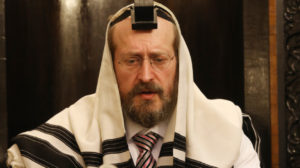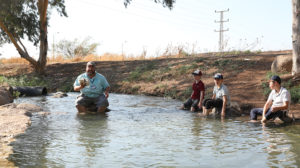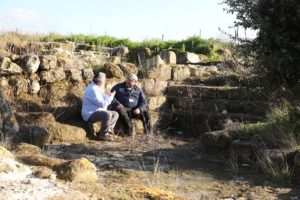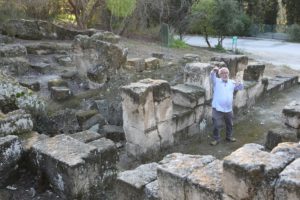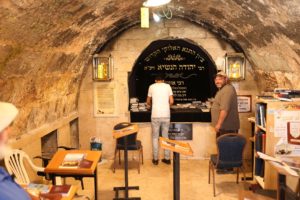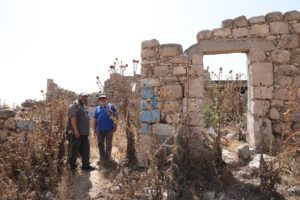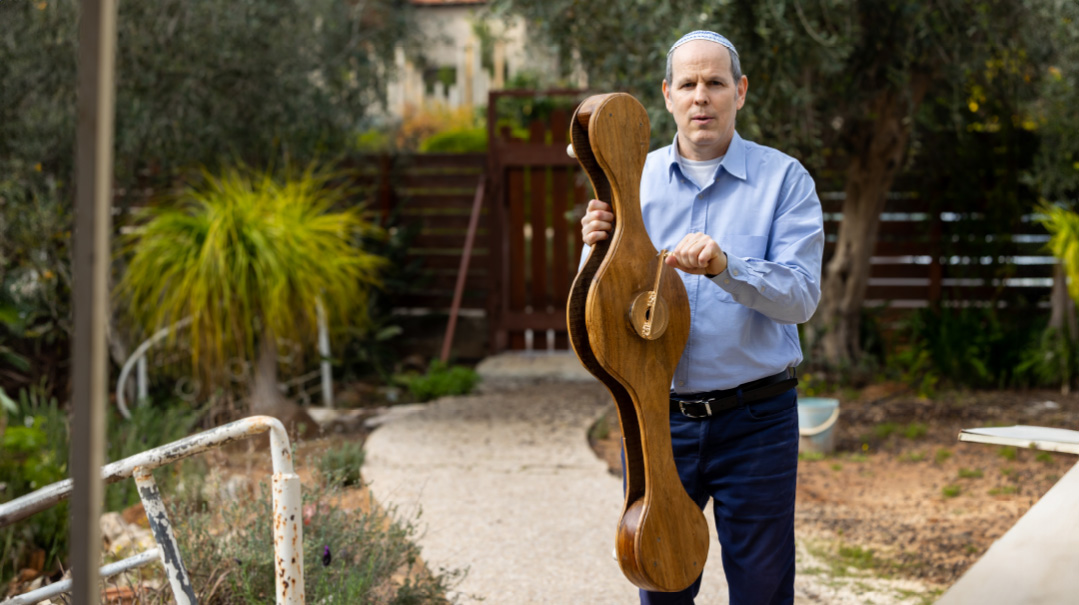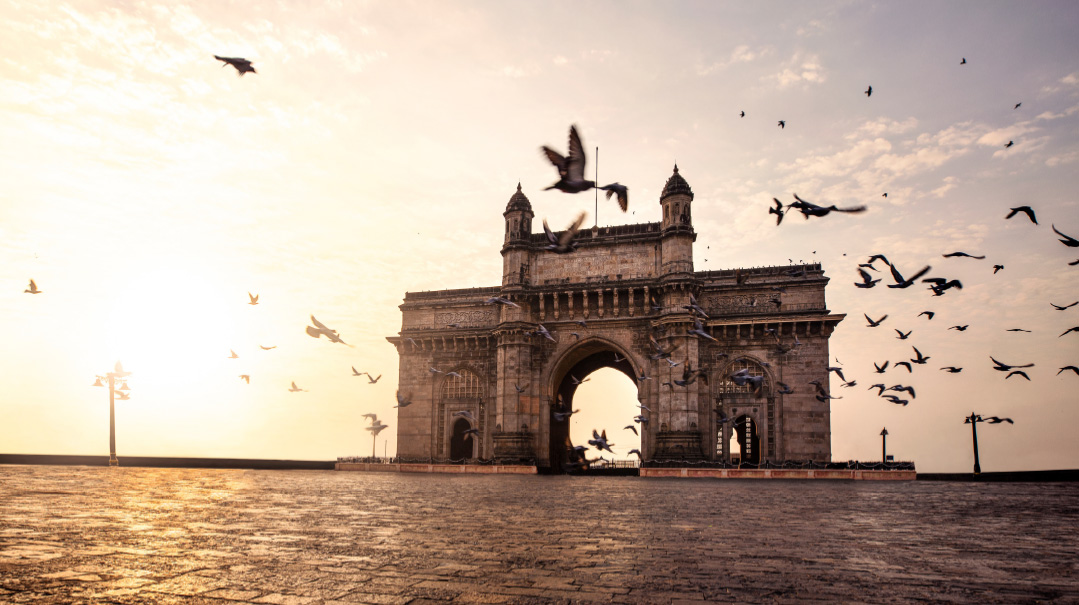The Hills Are Alive
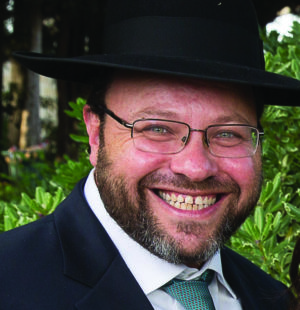
Sometimes to have a great trip, all you need is a Tanach
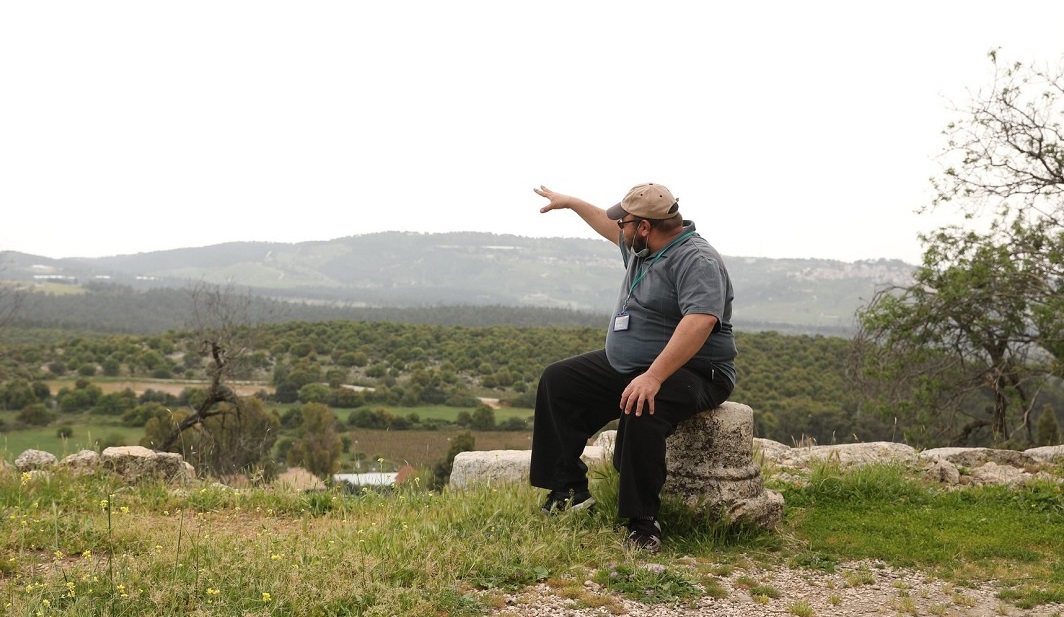
Photos: Menachem Kalish
O
f course, you can pack a tent, bedrolls, a canteen, and lots of meat for an impromptu barbeque, but sometimes to have a great trip, all you need is a Tanach. Is there any better way to reclaim the hills where the battles of history, and of our very collective soul, were fought?
“Ein lanu shiur ela haTorah hazos — all we have left is our Torah,” Rav Yitzchok Hutner ztz”l would tell his students. “Let’s not lose that too…” Rav Hutner would say that centuries ago the study of Tanach, the knowledge of dikduk, and the passion for Eretz Yisrael was so much greater, yet became diluted as they were “appropriated” by the Christians, the intellectuals of the Enlightenment, and the secular Zionists.
Still, despite the fact that the sounds of Tanach study may not be heard as loudly from many batei medrash, a tiyul around Eretz Yisrael can’t help but ignite the long-ago passion and enthusiasm and restore the study of Tanach to its proper place. Here the land itself — where the stories we’ve learned since elementary school actually took place — calls out to us and sings those ancient songs. Today’s tour in Emek Yizrael in the lower Galilee literally makes the high drama of those stories come to life. So, if you’re in Eretz Yisrael and still have a few days until the next zeman starts, pack up a knapsack and join me. And if not, you can still open your Navi and connect in real time.
Women’s Intuition
We begin our tour at the foot of Har Tavor — one mountain you can’t miss. It’s not part of any mountain range, but rather rises abruptly from the surrounding flat land, reaching a height of over 1,800 feet. The base of the mountain is surrounded by Arab villages, and we’re starting out at Shibli, the access point to the mountain. The Bedouins who live here are not like those who live in tents and tin hovels in the Negev and on the side of the road between Jerusalem and the Dead Sea. These tribes, or chamulas, live in beautiful homes, are gainfully employed, and a large portion of them serve in the army, with some even being decorated officers for their service in battle. Perhaps they’re the spiritual descendants of the family of Chever HaKeini and the tribe of Yisro who lived here during the time of Devorah and Barak. They also joined forces with the Jews in the battle that took place right where we’re stationed.
As we drive up this historic mountain that towers over the surrounding plain, we have a better appreciation of its argument before Hashem that the Torah should be given upon it because of its majestic height. But sadly for it, as we know, Hashem wasn’t looking for height. Quite the opposite: Hashem wanted a mountain that would symbolize humility, which Tavor’s high flat summit certainly doesn’t bespeak. To prove the point, it seemed providentially arranged that as we arrived, a group of Israelis were getting their paragliding and hang-gliding wings ready for their hour-long soar above the magnificent valley below. This is a place from where to look down on everyone else.
The best lookout point on the top of the mountain is the courtyard of the Franciscan Church, whose spires can be seen from all over the Galilee. I don’t like churches and don’t go into them, although I’d been to some of their courtyards during my studies. But as I consider that writing for Mishpacha is avodas kodesh, I wasn’t sure if we should go there for the lookout and video photo shoot. Hashem saved us from having to make the decision: Upon arrival we discovered that the church had been closed to tourists since Covid. Instead, we took an amazing circular hike around the mountain peak, which helped us envision the famous biblical battle on these slopes.
Looking at the valley below, we imagined the armies of Sisra (Shoftim 4) with his 900 chariots who had come down under the bidding of Yavin, the Canaanite king of Chatzor (where the ancient city’s ruins still remain). Looking below, we understood why Devorah Haneviah chose this area to draw Sisra into battle. The flat valley in contrast to the generally hilly Galilee was too tempting a location to best utilize his chariots — the equivalent of today’s tanks. He expected the battle against the Israelites to take place there; little did he know that Devorah, Barak, and his troops were actually stationed in the hills above, preparing for a surprise attack. It was Pesach time, and the normally dry valley where the Kishon River flowed enlisted the heavens to assist Devorah and Barak (who were hidden above on Har Tavor and the surrounding hills of Givat Ha’moreh): Torrents of pelting rain came down, turning the entire valley into a muddy swamp that incapacitated the chariots and swept their riders into the river and drowning them, forcing Sisra, the lone survivor, to flee on foot.
As we circle the peak of Har Tavor, we have a clear view of Teveria, the Kinneret, and the town of Yavne’el, which many archeologists suggest was the location of the ancient settlement of Alon Ba’Tzananim, where the tents of Chever HaKeini were pitched and where Sisra fled to. (There’s even a mesorah in modern Yavne’el that the natural spring mikveh, known as “Mikveh Malkah,” was connected to the miracle that took place with Yael, and many yeshuos are still attributed to its miraculous properties.) Chever’s wife, Yael, invited him into her tent for refuge. He had merely asked for water, yet she gave him a nice warm glass of milk. She followed that up afterward with some “stake,” but not the type you eat. Rather she used the tent peg to kill him.
She detoured Barak, who was giving chase, and showed him her conquest; and Devorah thus sang her song praising Yael and putting her on par with the “Imahos of the tent — Sarah, Rivka, Rachel and Leah.” We remember this story twice each year, as it’s the haftarah for Beshalach and the Splitting of the Sea, and the Gemara’s hint to the 100 shofar blasts on Rosh Hashanah corresponding to the cries of Sisra’s mother, who had expected her little boychik to come home with the plunder of the Jews and instead was defeated by women. Your Elul homework is to reveal the deeper significance of this evil woman’s cries and our earthshaking shofar blasts.
Holy Homestead
The next stop on our Tanach trail is the Arab village of Sulam, but there’s much more to this dusty Arab town than meets the eye. In the times of the first Beis Hamikdash this was the flourishing Jewish city of Shunam, mentioned in Sefer Yehoshua as the border of Shevet Yissachar just north of Afula. As opposed to many Arab villages whose residents fled after their capture in the War of Independence, Sulam was on good terms with its Jewish neighbors and its residents remained. Tel Shunam, where the ancient city was discovered, is currently a cemetery and the current village is built around it. Our destination is one of the most off-the-beaten-track holiest sites in Israel: The house of the Ishah HaShunamis.
In the times of Bayis Rishon when the kingdom was divided, this area was part of the Kingdom of Israel and Ten Tribes that had broken off from Yehudah and Binyamin after Shlomo Hamelech’s death. During the reign of the children of Achav, Elisha Hanavi was the spiritual leader of the Jewish people and he would travel around the country with prophecies of both chizuk and rebuke (Melachim II, 4). The city of Shunam found a special place in his heart though, and the Ishah Shunamis, who according to Chazal may have been either the wife or mother of the prophet Ido, had a special room built for him. He showed his appreciation to her by blessing her that she would be hugging a child after she had been barren for many years. (The Zohar tells us the child that was born was the prophet Chavakuk — named after the promise of chibuk – hugging — that Elisha gave her.) It seems that the blessing came with even a post- lifetime warranty, for a few years later when the child died in the field, the woman came running to Elisha, who arrived quickly on the scene and brought the child back to life.
There is one more story about this holy woman (Melachim II, 8). Elisha tells her that there will be very soon a devastating famine in the land and sends her and her household to the land of the Plishtim to wait it out. When she returns after seven years, she discovers that in her absence all of her land and possessions had been stolen. She goes to King Yehoram, who at that precise moment is hearing from Geichazi, Elisha’s wayward disciple, about the various miracles of his master. Talk about good timing! The king is impressed meeting this woman and returns all of her property to her.
Our destination in Sulam is just one small little wall. Located in between some houses on a side street, it marks what was once an entrance to a cave that has traditionally been considered the home of this Ishah Hashunamis. There aren’t too many places where Rav Chaim Kanievsky has left to Bnei Brak to go daven, yet this place is one of them. And it’s known that he has sent many who are in need of miracles to daven here as well. He has a tradition from his father, the Steipler Gaon, that the inspiration of the miracles that happened as a result of the prayers offered up here are the real deal. People who are having fertility challenges, acute or terminal illnesses, or parnassah issues come from all over the world to this small little wall and pray — and in the merit of Elisha and this holy woman, have seen their tefillos answered.
“Yoohoo, Yehu”
It’s been a hot season and today has been particularly brutal, so we’re heading over to Ein Yizre’el, a cool spring in the heart of the valley to soak our feet and eat some watermelon. This spring is mentioned in Tanach as the place where Bnei Yisrael were camped before Shaul’s final battle with the Plishtim (Shmuel I, 31). It sits at the foot of Tel Yizre’el, where the ancient winter palace of Achav and his evil wife, Izevel, lived.
One could hike the kilometer or so uphill to the ancient ruin, or the tel. This tour guide though, on this sweltering day, preferred to drive in his air-conditioned SUV. We take a short hike around the Tel where there really aren’t too many remains to be seen, yet the view over the Yizre’el valley is truly spectacular. We can understand why Achav might have wanted to build his palace here. As well, we can appreciate the strategic military significance of the valley. To the north one can see the hills of the Lower Galilee, and to the south are the central mountain range of Gilboa and the Shomron. This was the easiest travel route from the coastline and Egypt in the south to Mesopotamia and Syria in the north. This hill is the perfect overlook and offers control over the entire middle of this valley — and the ancient kings knew it too.
Below us are the fields growing their produce in the flat plains, and we spot some vineyards as well. I can imagine wicked King Achav looking down from this vantage point, coveting the vineyard of Navos to add to his personal royal fields and gardens (Melachim I, 21). The text tells us that when Navos refused to sell it to him, his wife Izevel “solved the problem” — she engaged false witnesses to testify that Navos had blasphemed and had him put to death. That crime so incensed Hashem that He sent Eliyahu to tell Achav that he, his wife, and his descendants will die and be discarded to the dogs, who will lick their blood. Achav actually took the rebuke to heart, rent his clothing, and did teshuvah. Thus, his kingdom was allowed to reign for an additional 22 years, although ultimately, he died in battle and the prophecy was fulfilled. His wife and sons were as well later killed by Yehu, who had been appointed by Elisha and who had Izevel thrown from the window, but not before she made herself up with her best feminine wiles and waved at him in order to attract his attention. Perhaps that palace window was right where we’re standing, as the dogs below took care of the rest of the job.
Drink to That
From Tel Yizre’el it’s a short drive to Ein Charod, a natural spring that flows from Nachal Charod, which is one of the large rivers that flows into the Jordan. Above us towers the Gilboa mountain range, and yet as we sit in a cooling natural pool right outside the small yishuv aptly named Gidona, after the shofet Gideon, we can pull out our Tanach and read the stories of that famed shofet and his small army that rested here.
It was a bad time for our nation, the people stuck in a cycle of worshipping avodah zarah, Hashem sending an oppressor to torture them, then the nation crying out in desperation, and finally Hashem sending forth a savior, or judge. At this particular point, Hashem sent the Midianites to terrorize the nation — and hopefully awaken its sleepy sinners.
After seven years of torture, Hashem sends an angel to Gideon (Shoftim 6-8) telling him that he has been chosen to lead the Jewish people to victory. After a fair amount of Gideon’s skepticism being put to rest by various signs from Hashem, he puts out the word and marshals 30,000 soldiers right over here to Nachal Charod. A problem arises though: There are too many people, and Hashem wants the forthcoming miraculous victory to look just like the miracle it is. It wasn’t the strength of the ancient IDF that was going to win this war.
I had brought along my assistant tour guide ,Tully, who happens to be my son and whose mother wanted him out of the house for the day with his friends. (After all, what’s the point of having a father as a tour guide?) They served as my “soldiers” and I ordered them to take a drink from the fresh spring, just like Gideon did in order to sift out and select the most appropriate men to fight what would be a miraculous victory. It seems they had all learned the story in Shoftim, as none of them got on their knees and lapped like a dog, which would’ve demonstrated a proclivity for avodah zarah. Gideon’s soldiers didn’t fair that well, though; 20,000 had already been sent home because of their fear, and of the remaining ten thousand, only 300 raised the water up to their mouths to drink. And so, Gideon got his army — against thousands of Midianim and Amalekim who had spread out and covered the entire valley below.
Fast-forward 3,000 years, and during the 1930s, Israel faced similar odds against their Arab neighbors who were not happy about the growing Jewish presence. The fledgling Jewish defense forces at the time were essentially made up of young teen refugees from Europe with no military training — until Major General Orde Wingate, a decorated British officer who was enamored of the Bible, came around. He saw in the Jewish struggle a battle of biblical significance and was inspired to help. He thus formed the Special Night Squads, which in its peak numbered about 100 soldiers — among them Moshe Dayan and Yigal Alon — whom he trained with a Tanach in his hand, recounting to them this battle of Gideon and other similar military strategies of the few against the many. All the while he encouraged and strengthened this mostly secular Jewish army with words of faith and emunah, and how this army of Hashem would be granted victory.
Gideon had his men surround the Midianite army from all sides, and at a given signal at midnight (bachatzi halailah — of the Pesach Seder) they would all shatter earthenware jugs they had brought that contained torches in them. One might call them the first Moltov cocktails. He then had his soldiers blow shofar blasts as they yelled “For Hashem and for Gideon!” All that noise sent the Midianite army into a panicked frenzy and they fled, trampling and killing one another, as Gideon and his men chased them across the Jordan, running through the city of Beit Shean.
With that battle in the modern military consciousness, during the War of Independence, Avraham Yoffe led Operation Gideon, a battle for the city of Beit Shean. The British had left the city in April of 1948 and the fight for the city began. The Jews were once again outnumbered, yet Yoffee recalled the lessons he learned from General Wingate. He didn’t have earthenware jugs, but the strategy was the same: He shelled them with the few “Davidka” mortars that were known for making lots of noise but didn’t cause much damage. The Arabs bought into the bluff, and, fearing imminent defeat, surrendered without any Jewish losses.
As we’re winding up our ancient and modern history lesson, we see we have company. A bunch of Army jeeps pull up and groups of soldiers from units we couldn’t at first identify step out and begin to relax around the spring. To my surprise, about a third of the soldiers strangely have American flags on their uniforms. When I go over to schmooze with them, they share, a little reluctantly, that they’re actually US Navy Seals here to receive tactical training from their Israeli counterparts. This time, it was Orde Wingate in reverse — the Jewish IDF training the non-Jewish American army! It seemed that these soldiers, though, definitely were not up on their Tanach. We watched amusedly as they mostly lay flat down and prostrated themselves to drink from the water. This is what we call a true Israeli experience — it doesn’t get much more real than this.
The Last Battle
As the sun sets, we make our way up Har Gilboa to the slope called Har Shaul. My son points out to me how most of the mountain is covered with large fir trees, yet there is one large slope that remains empty and bare. I open up my Tanach one more time today and begin to read the story of Shaul’s last battle that took place here — and that will answer the riddle of the bald mountain top.
The end of sefer Shmuel Alef tells how Shaul, his sons, and the Jewish army stood on this very mountaintop as the Philistine army stood across the valley below on Givat Hamoreh. Prior to this battle, Dovid had fled to Plishti territory out of fear of Shaul. From there he went off to fight against the Amalekites in the south, and the Plishtim felt that with Dovid out of the way, the time was now ripe for the final attack. Shaul, who was at a loss for guidance after the death of Shmuel, had in desperation disguised himself and visited the witch of Ein Dor, requesting that she bring up Shmuel from the dead for a quick consultation. The ruins of that town are located right below us, not far from the current Kibbutz Ein Dor. Meanwhile, she raises Shmuel up and he is not a happy camper. He tells Shaul that the battle will be lost and that he will very soon be joining him on the other side. Oy.
Shaul takes his words to heart, but still pushes forward to continue the battle. The battle takes place in the valley below and the Jews are chased up the mountain and slaughtered by the Plishtim. Yonasan and Shaul’s other sons are killed and Shaul himself falls on his sword, in order that the Plishtim should not take him and mutilate him in their notoriously horrific way. When Dovid hears of the terrible loss, he comes to this spot and eulogizes his father-in-law and beloved brother-in-law Yonasan with the words “Eich naflu gibborim — Oh, how the mighty have fallen,” and he curses Har Gilboa that it shall always remain barren to remind us of the tragic deaths that took place here.
As we look out at those barren slopes, we can’t help but think about the battles that have been fought, the heroes and leaders that have fallen, and the eternal inspiration that Eretz Yisrael possesses for her children who once again are privileged to live on these sacred hills. With our Tanach, our land, and our national memory, may the shofar that we begin to blow this coming Elul herald in the final geulah with the coming of Mashiach when we reclaim it all.
(Originally featured in Mishpacha, Issue 872)
Oops! We could not locate your form.
